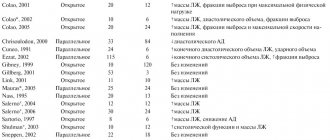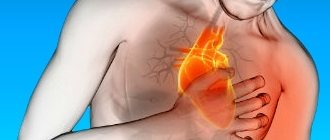Heart rhythm disturbance - arrhythmia
As a rule, we do not notice how our heart works. But it happens that subjective unpleasant sensations arise - the heart “flutters” (atrial flutter), “freezes,” as if “turns over.” If such sensations are constant, and are also accompanied by other symptoms: shortness of breath, weakness, chest pain, then consultation with a cardiologist is necessary. It is likely that the cause is heart disease - ischemic heart disease (coronary artery disease), cardiomyopathy (changes in the heart muscle, often of unknown cause), pericarditis (inflammation of the pericardium, often associated with the accumulation of fluid in the pericardial cavity), heart disease (a disease associated with anatomical disorders structures of the heart, namely valves, septa, cardiac openings).
The influence of being female on the prognosis of cardiovascular pathology
According to WHO, symptoms of heart disease in women appear later and are more severe than in men. Representatives of the fairer sex are 16% more likely to die from myocardial infarction and are predisposed to a relapse. The reason for these consequences is that 92% of women do not see cardiac pathology as a threat to their lives, being more wary of the occurrence of tumor processes.
Director of the Women's Heart Clinic, American cardiologist Sharon Hayes comments on these indicators: “There is some discrepancy: women are confident in the danger of cardiac pathology, but are more afraid of breast cancer.” Even doctors themselves have long used the so-called “bikini approach” to assess women’s health indicators.
The focus is on the reproductive system and breast cancer prevention. At a young age, they add concern for the condition of the expectant mother and fetus. And the fact that in every third case women die precisely because of CV diseases is missed.
Lack of air - shortness of breath
The condition of shortness of breath - difficulty breathing, lack of air - indicates heart or pulmonary failure. Cardiac shortness of breath initially develops with physical effort and goes away when the load stops. But as the disease progresses, shortness of breath can overtake a person, even when he is at rest, and even just lying down. This is already a formidable symptom.
Cardiac dyspnea usually manifests itself as difficulty breathing.
A specialist can distinguish between cardiac and pulmonary shortness of breath. In any case, both symptoms indicate serious health problems.
How does CVD care differ by gender?
A paradox in providing assistance when symptoms of cardiovascular disease appear is the frequency of ambulance calls. People react immediately if chest pain occurs in men, and delay calling 103 if the same symptoms occur in women. Moreover, such actions are often determined by the behavior of the patients themselves.
In most drug instructions and many clinical guidelines, information about optimal doses and side effects regarding the fair sex is missing, or is not sufficiently clarified. Although the fact of the influence of anatomical and physiological characteristics on the pharmacokinetics and pharmacodynamics of drugs has long been proven:
- women have a higher percentage of body fat, lower glomerular filtration and creatinine clearance;
- fluctuations in the amount of tissue fluid and sex hormones during menstruation;
- characterized by a frequent increase in heart rate and a decrease in the duration of the cardiac cycle compared to men.
The above features play a significant role in the development of adverse reactions to medications. For example, it became known that the body of women reacts weaker to nitroglycerin. Therefore, it would be advisable for pharmaceutical developers to dwell in more detail on the gender characteristics of the effects of medications, and for attending physicians to take them into account when prescribing drugs.
Frequent/slow pulse – tachycardia/bradycardia
The pulse can be used to judge such an important indicator as heart rate (HR).
Normal is considered to be from 60 to 100 beats per minute (naturally, under load and stress, the pulse quickens).
When pulse values are above this indicator, they speak of tachycardia, below - bradycardia. Both conditions are quite dangerous. Low heart rate is especially serious - less than 40 beats per minute, it can cause cardiac arrest.
4. Cardialgia – pain in the heart
Pain due to heart problems is localized both on the left, where the heart is located, and in the center of the sternum.
It can radiate to different parts of the body - into the arms or one hand (usually the left), back to the back and even to the jaw.
Pain develops following physical exertion, after emotional stress, hypothermia, or eating large amounts of food.
The pain can be of a different nature: pressing, cutting, aching, squeezing. She can "bake."
Pain most often accompanies coronary heart disease (CHD) and is called angina. But cardialgia is also characteristic of other cardiovascular pathologies, in particular arterial hypertension, pericarditis, myocarditis, cardiomyopathy, etc.
Pain in the heart area can also be caused by other, non-cardiac pathologies, but it is better if a doctor understands this. Therefore, any cardialgia is a reason to consult a cardiologist.
How to distinguish heart disease from others
Many people experience chest pain not necessarily due to any heart disease. Often this occurs due to another illness. If your heart hurts, it can be caused by diseases of the musculoskeletal system, respiratory, digestive and other diseases. However, only a doctor can make an accurate diagnosis after examining the patient.
But any person who has experienced such signs should understand if the heart hurts, what to do and how to recognize that it really is a heart disease. You need to know this in order to promptly consult a specialist in case of some serious pathologies. The signs of the disease may vary; you must learn to recognize them. The most important thing is to distinguish between cardiac and non-cardiac pain. For this purpose, you need to know the duration and intensity of the attack. In addition, it is advisable to have information about other diseases whose symptoms are similar to those of the heart.
The first symptoms of a heart attack
Discomfort in the chest can occur for various reasons. To understand that the heart hurts, it is advisable to know several characteristic symptoms. Seizures are not always accompanied by unpleasant sensations. At the same time, people with other ailments complain that they have difficulty breathing and pain in the left side of their chest. But all this is not a consequence of cardiac diseases.
The earliest signs that indicate that the functioning of the human body’s motor system is impaired most often appear several months, or even years, before the first attack. Therefore, everyone should know how and where the heart hurts. Early signs of the disease that should alert you are:
- Painful sensations behind the ribs. They hit the back, arm, neck, teeth. The left side is most often affected. At the same time, there is shortness of breath, nausea, and increased sweating.
- Discomfort after physical activity, stress, which disappears after rest or nitroglycerin tablets.
- Shortness of breath appears even with moderate exertion, simple work, while eating, and even in a lying position. Before the attack begins, the patient may sleep while sitting or suffer from insomnia.
- Severe fatigue from usual activities can begin long before the first attack.
- Representatives of the stronger sex sometimes develop erectile dysfunction several years before the diagnosis of coronary artery disease.
- Swelling. This symptom is considered the most basic evidence of cardiac dysfunction. At first, the swelling is almost invisible, but becomes larger over time. This is noticeable when a person removes shoes or rings from their fingers. If swelling is observed, you should consult a specialist and undergo an examination.
- Stopping breathing during night sleep, as well as snoring. These signs indicate a predisposition to an attack of heart disease.
Signs of coronary diseases
1. Myocardial infarction
Heart attacks can occur in different ways and how the heart hurts , symptoms in women and men in different situations can be different. In the case of myocardial infarction, everything happens approximately like this:
- There is a feeling of heaviness, pain in the central part of the chest, arm.
- Discomfort spreads to the left arm, neck, throat, and lower jaw.
- You feel dizzy, sweating, your skin becomes paler, and you feel nauseous.
- There is a feeling of heaviness in the stomach, a burning sensation in the chest.
- Anxiety, weakness.
- Rapid pulse.
The course of a heart attack may be different. Sometimes there are no signs at all. Sometimes the patient says that he experiences discomfort in the chest, sometimes there are no such symptoms and the process can be painless. Signs of a major heart attack: shortness of breath, blue lips, etc. very similar to symptoms of acute heart failure.
The duration of such an attack is approximately thirty minutes. Nitroglycerin doesn't help at all.
2. Ischemia
The main manifestation of IHD is angina attacks. In this case, pain occurs in the heart; the symptoms are the same in women and men. Among them:
- cardiopalmus;
- dyspnea;
- cardiac dysfunction;
- inconsistent pulse;
- dizzy, nauseous;
- weakness, sweating.
With coronary artery disease, patients report that they have a burning sensation and pressure in their chest. There is a feeling of being overwhelmed. Often unpleasant sensations are transmitted to the arm, neck, and throat. Most often observed during physical activity, stress and stop when the person remains alone.
With angina at rest, pain in the heart, the causes of which are different, appears at any time, even at night. This form is considered unfavorable.
Inflammatory heart diseases
1. Pericarditis
Pericarditis is an inflammation of the outer lining of the heart, the main symptom of which is a dull pain in the heart area. The pain is usually in the center of the chest, in some cases it radiates to the arm, back, and neck. When swallowing, coughing, etc. discomfort intensifies. Lying down makes it worse, sitting up makes it better. Although the nature of the soreness is usually dull and aching, in some cases it can be acute. Pericarditis is also characterized by rapid heartbeat.
2. Myocarditis
Inflammation of the myocardium is one of the reasons why the heart hurts; approximately 90 percent of people complain about it. Its form can be different, it appears regardless of physical activity, but after some time it can become stronger. Nitroglycerin doesn't help.
Heart valve diseases
If valve disease is present, its severity cannot be judged by symptoms. The patient may not complain about anything and still be in serious condition. Main symptoms:
- Shortness of breath, which is observed not only during high loads, but even during the most usual activities and in a supine position;
- Discomfort in the chest during exercise, breathing in cold air;
- Weakness, dizziness;
- Heart rhythm disturbance. These are, in particular, an uneven pulse, rapid heartbeat, and disturbances in the functioning of the heart.
This pathology often leads to heart failure. Then the following symptoms appear: the legs swell, the stomach bloats, and body weight increases.
Cardiomyopathy
Almost all people who have this pathology complain of pain. As the disease progresses, the way the heart hurts and the symptoms change. At first, the pain is long-lasting, does not depend on physical activity, and nitroglycerin does not help. Feels in different places. Then it is spontaneous or paroxysmal in nature after exercise and most often goes away after taking a nitroglycerin tablet. Its character can be different, its localization is precise, but sometimes it spreads over a large area. Nitroglycerin does not always help.
Arrhythmia
There are several types of arrhythmias. They are characterized by changes in heart rhythm. There are several types of ailments that cause heart pain radiating to the left arm.
Heart defects
These diseases can be acquired or inherited. For a long time they may not talk about themselves. Sometimes your heart hurts; your doctor should tell you what to do. This pain is usually aching, cutting or stabbing in nature. Accompanied by high blood pressure.
Mitral valve prolapse
Aching or pressing pain that appears on the left side is not caused by physical activity. They do not stop after taking nitroglycerin. In addition, dizziness, rapid heartbeat, and headaches may occur in the morning and evening. Possible shortness of breath, lightheadedness.
Aortic stenosis
With this disease, there is a pressing sensation in the chest. There is a strong heartbeat, weakness, fatigue, shortness of breath during physical activity. Over time, shortness of breath and dizziness occur during night sleep. If you suddenly change your body position, you may faint. Attacks of asthma and angina pectoris are possible.
Thromboembolism of the pulmonary artery
This is a very serious condition that requires immediate attention. The first sign of the disease is a stabbing pain in the heart area, which becomes stronger when inhaling and does not radiate to other places. The patient's skin turns blue, blood pressure decreases, shortness of breath and rapid heartbeat appear. Nitroglycerin has no effect.
Aortic pathologies
Sudden, very strong painful bursting sensations in the chest are a consequence of aortic dissection. They are sometimes so painful that a person can lose consciousness. The patient needs emergency medical care.
If there is an aortic aneurysm, there is aching or throbbing pain in the heart, a specialist must decide what to do. If an aneurysm ruptures, the pain becomes unbearable. If measures are not taken, death may occur.
Non-cardiac diseases
1). Intercostal neuralgia. Many people who feel such pain in the heart area mistake it for heart pain. However, in reality they are different. With neuralgia, the pain is sharp and stabbing in nature. They intensify when coughing, deep breathing, sudden turns of the body, etc. This can go away quite quickly, sometimes the pain lasts for several hours. The patient can accurately determine the location of the discomfort; it is located between the right ribs. In the case of angina pectoris, a person experiences a burning, aching feeling that does not go away when the position of the body changes. It is impossible to determine the exact location.
2). Osteochondrosis. This disease is quite easy to mistake for angina pectoris. The person is sure that his heart hurts, the symptoms are as follows: numbness occurs in the left hand, and it becomes more painful when moving. All this is especially similar to angina pectoris when an attack occurs during night sleep. The main difference is that nitroglycerin does not work.
3). Diseases of the central nervous system. In such a situation, patients often complain. However, symptoms vary. This can be regular, short-term, acute or aching pain in the heart area. Neuroses, as a rule, are characterized by a variety of vegetative disorders. A person may experience anxiety, insomnia or, on the contrary, increased sleepiness. Your hands get cold or cold, your head starts to hurt, and much more. Often patients suffering from neuroses complain, talking about numerous symptoms that they do not actually experience. And the “core people” are very reserved in sharing their feelings. Sometimes it is difficult to understand whether a patient has ischemic heart disease or cardioneurosis, since the cardiogram does not show any changes.
4). Disturbances in the functioning of the gastrointestinal tract. However, in this case, heart pain symptoms are somewhat different. They last longer, and the person feels nauseous, vomits, and develops heartburn. The intensity is determined by food intake. Often the symptoms of acute pancreatitis are similar to myocardial infarction. Sometimes exacerbations of gallbladder diseases radiate to the left half of the chest and it seems that the pain is in the heart. To understand what the problem is, you should take antispasmodics. If relief occurs, then the patient has gastrointestinal diseases.
5). Pulmonary diseases. Painful sensations similar to heart pain sometimes appear with pneumonia. This can also happen with pleurisy. But in this case, the pain is acute, intensifying with inhalation and coughing.
What to do?
Every person who feels pain in the chest thinks about what to do next. If there is any suggestion that your heart is hurting, you need to take immediate action. After all, the cause may be serious, in particular myocardial infarction or an attack of angina. Therefore you need to do the following:
- You should calm down and sit down. A stressful state will only worsen the situation.
- You need to try to take a different position. If after this there is relief, there is a possibility that the reason is different. If the pain increases, a pressing pain appears in the heart area, there is a risk that it is angina pectoris.
- It is recommended to allow access to fresh air and open a window.
- To prevent breathing from being constricted, you need to make your clothes looser, unbutton your collar
- If you suspect angina, take a nitroglycerin tablet and place it under your tongue. If relief does not come within a quarter of an hour, you need to take another tablet. You should call for emergency assistance. The medicine does not work for a heart attack.
Finally
Even if the pain in the heart area, the cause of which must be determined by a specialist, has gone away, you need to go to the hospital as soon as possible and get examined. Self-medication is unacceptable.
In Nizhny Novgorod, you can undergo a preventive examination at the Road Clinical Hospital, where professionals work.
Blue lips – cyanosis
If this happens not because you are cold, and is accompanied by blue nails and increased heart rate, then this is a very bad symptom. It indicates that there are disruptions in cardiac activity and the heart does not provide the body with oxygen. Blue lips and nails are characteristic of heart disease.
Legs can swell not only with heart disease, but also with kidney problems, varicose veins, and liver damage. Cardiac edema has characteristic features. Such swelling develops gradually, affecting the ankles of both legs, rising to the shins. The skin at the site of swelling is dense, cold (feet often get cold), and has a bluish tint. The swelling is painless, even when pressure is applied to it.
Such swelling, accompanied by other symptoms of heart problems, indicates developing heart failure, so they are the reason for contacting a cardiologist.
All of the above signs, especially if they appear in combination, cannot be ignored. The heart is no joke - myocardial infarction, stroke, cardiac arrest can occur suddenly. To prevent this from happening, you need to promptly contact a cardiologist, undergo an examination, identify the disease and follow all the doctor’s recommendations.
Treatment of heart pain
Pain is a symptom and therefore cannot be treated in itself. The method of therapy is selected only after determining the cause of pain.
Treatment begins with lifestyle changes: it is important to include all recommended ways to prevent heart disease in your list of daily activities.
Diet plays an important role: fried and fatty foods and sweets are excluded from the diet. The daily menu should contain a sufficient amount of fresh vegetables and fruits and fiber.
The patient is also offered to add physical activity to his daily routine - the duration and types of exercise are determined individually, depending on the identified disease.
Drugs for the treatment of heart disease are prescribed in a course or for long-term use. It is important to control blood pressure: for hypertension, medications must be taken daily, following the doctor's recommendations.
Pain resembling osteochondrosis
Pain between the shoulder blades, in the neck, left arm, shoulder, wrist, even in the jaw can be a sure sign of not only osteochondrosis or myositis, but also heart problems.
Article on the topic
Stroke: risk factors, dangerous symptoms, first aid A symptom of angina pectoris may be the occurrence of such symptoms after physical activity or emotional shock. If pain occurs even during rest and after using special heart medications, this symptom may indicate an approaching heart attack.
How the heart works
The most tireless organ is located in the center of the chest, with most of it on the left side of the body.
The heart is housed in a sac around the heart called the pericardium. This dense sac keeps the organ in a stable position, preventing it from shifting and deforming under stress.
The walls of the heart are formed by three layers:
- The epicardium is the outer serous membrane.
- The myocardium is the middle layer that provides muscle contractions of the organ.
- Endocardium is a thin membrane lining the inside of the heart cavities.
The heart has four elastic valves. These kind of flaps prevent blood from moving in the wrong direction.
The tireless muscular organ is formed by two atria and two ventricles. Each of these chambers has a special role in the blood circulation process.
to contents ^
How is diagnosis carried out by a cardiologist-arrhythmologist?
Diagnosis of diseases treated by a cardiologist-arrhythmologist is usually carried out using the following tests and studies:
- ECG - atropine tests;
- Phonocardiography;
- ECG;
- ECG in a state of physical activity;
- ECG - monitoring for 24 hours;
- Ultrasound of the heart;
- General urine and blood tests;
- Diagnostics for atherosclerosis;
- Analyzes for the degree of development of cardiac risks, such as high cholesterol and others;
Palpitations
Palpitations can occur during intense physical activity, as a result of a person's emotional arousal, or due to overeating. But a strong heartbeat is very often an early warning sign of cardiovascular disease.
A strong heartbeat manifests itself as a feeling of disruption in the functioning of the heart; it seems that the heart is almost “jumping out” of the chest or freezing. Attacks may be accompanied by weakness, discomfort in the heart, and fainting.
Such symptoms may indicate tachycardia, angina pectoris, heart failure, or impaired blood supply to organs.
If you have at least one of the listed symptoms, it is important to immediately consult a doctor and undergo tests that will reveal the true cause of the ailment. One of the most effective methods of treating any disease is its early diagnosis and timely prevention.
Working for a living
Continuous work of the heart - rhythmic contractions (systole), alternating with relaxations (diastole). During relaxation, the chambers fill with blood, and during contraction it is expelled.
- From the left ventricle, blood is pumped into the largest artery in the body, the aorta. Through it, blood flow is directed through organs and tissues, delivering oxygen.
- From them, blood moves through the veins and ends up in the right atrium.
The path taken is called the systemic circulation.
- From the right atrium, blood moves to the right ventricle. From there it is released into the pulmonary arteries and moves along them to the lungs. There, in the process of moving through the capillaries, it is enriched with oxygen and freed from carbon dioxide.
- The enriched blood arrives through the pulmonary veins into the left atrium.
This movement of blood flow, aimed at oxygen saturation, is called the pulmonary circulation.
- From the left atrium, blood enters the left ventricle. The movement is repeated again.
This is how the heart ensures the normal functioning of all systems and organs, saturating them with oxygen.
to contents ^
Diagnosis of hypertension
Diagnosis of hypertension is performed by a cardiologist. To identify the disease and individualize treatment, the following methods are used:
- dynamic blood pressure measurement;
- laboratory tests - clinical and biochemical blood tests, general urine analysis;
- electrocardiography, including in the form of Holter monitoring;
- ultrasound examinations: heart, kidneys and other organs;
- Dopplerography (ultrasound of blood vessels).
conclusions
The most common cause of death among men and women around the world is cardiac disease. The risk of developing heart disease especially increases in women after 50 years of age. Sometimes simple fatigue, lower back pain or indigestion are the first symptoms of heart disease in women. Therefore, it is so important to know what signs of cardiac pathology are manifested. Timely diagnosis and proper treatment not only affect life expectancy, but also its quality. To be confident in the health of your heart, you need to visit a cardiologist at least once every 2 years, and after 40 years, preventive examinations should become an annual ritual.






